Ready to create a marketing plan that actually works? Learn more about what a marketing plan is, its purpose, and all the steps you need to create one.
What Is A Marketing Plan?
A marketing plan documents how an organization will execute its marketing strategy to actualize the organization’s vision.
Marketing Plan
Marketing plans are operational documents that outline target markets, goals, competition, content initiatives, budgets, editorial schedules, and process methodologies.
Marketing plans include:
- Marketing goals, objectives, and key performance indicators (KPIs)
- Target market and audience personas based on market research of pain points and solution expectations
- Competitive analysis and market trends
- Marketing initiatives, channels, tactics, and content
- Responsibilities and resource needs for people, processes, and technology
- Budget requirements to execute the plan effectively and efficiently
- Editorial scheduling, timelines, and execution methodologies
Marketing Strategy Vs. Marketing Plan: What Is The Difference?
Marketing strategy is what the company will do to actualize the organization’s vision, leveraging strengths while mitigating risks. The marketing plan documents how the company will actualize the marketing strategy.
1. Marketing strategy is what the company wants to do to achieve the desired states and outcomes for their business. A complete marketing strategy includes the company’s value proposition, brand messaging, agreed-upon strategic approach, and business objectives. Each strategic action item should align with top-level goals and ultimately fulfill the company’s vision statement.
Simply put, a marketing strategy is a philosophy that drives marketing decisions and keeps track of goals.
How will a business achieve its missions or goals?
- Launching campaigns
- Producing quality content
- Being active on customer-facing channels
- Keeping their marketing tech stack efficient
2. The marketing plan documents how the company will execute the marketing strategy to achieve the desired states and outcomes.
When building a marketing plan, be sure to add…
- In-depth research of the target market
- A list of marketing activities and when they will happen – monthly, quarterly, or annually
- A timeline of completion for tasks within the strategy
- Processes & workflows for implementation
- KPIs
What Is The Purpose Of A Marketing Plan?
A marketing plan helps you organize, execute, and track your planned marketing activities. It’s a strategic roadmap to actualize your business goals.

3 Types Of Marketing Plans
A word of caution about different types of marketing plans:
Marketing strategy is a comprehensive approach for the organization to actualize the vision by leveraging marketing skills, tactics, and resources.
Therefore, it is a humble opinion that there is only one marketing strategy—and one true marketing plan—per organization. Too many marketing plans likely indicate disconnects in the organization’s overall approach toward realizing its vision.
That said, various marketing plans may make sense for your organization to create based on marketing strategists’ specialization areas. Let’s take a look.
1. Tactical Marketing Plans
Tactical marketing plans align activities for a specific tactic to the marketing strategy.
Tactical Marketing Plan Examples:
- Paid marketing plans
- Influencer marketing plans
- Referral marketing plans
- Co-branding marketing plans
- Product launch marketing plans
2. Channel Marketing Plans
Channel marketing plans focus on optimizing a specific method or platform to actualize the marketing strategy.
Channel Marketing Plan Examples:
- Social media marketing plans
- Email marketing plans
- Event marketing plans
- Conference marketing plans
- SMS marketing plans
3. Marketing Content Plans
Marketing content plans align the focus of specific types of content with actualizing the marketing strategy.
Marketing Content Plan Examples:
- Newsletter marketing plans
- Podcast marketing plans
- Video marketing plans
- Landing page marketing plans
- Guest blog post marketing plans
How To Create A Marketing Plan
Here are some of the most common components of a marketing plan. If you’re curious, here is a full list of many (if not all) marketing plan components and elements you may consider when drafting your marketing plan outline.
1. Write An Executive Summary
An executive summary gives you a high-level overview of the document. Think of it as your marketing plan’s TL;DR.
Ask yourself these questions to highlight your marketing plan’s main points in the executive summary:
- What types of customers are you targeting?
- What patents or products will you market specifically?
- What unique partnerships will you leverage to succeed?
- How is your marketing plan special?
- How will your company stand out?
- What problem are you solving?
- What is the solution?
- Why now?
Some businesses use a paragraph or two for their executive summary, while others go more in-depth. HubSpot has a two-page marketing plan executive summary example with subheaders for each topic:
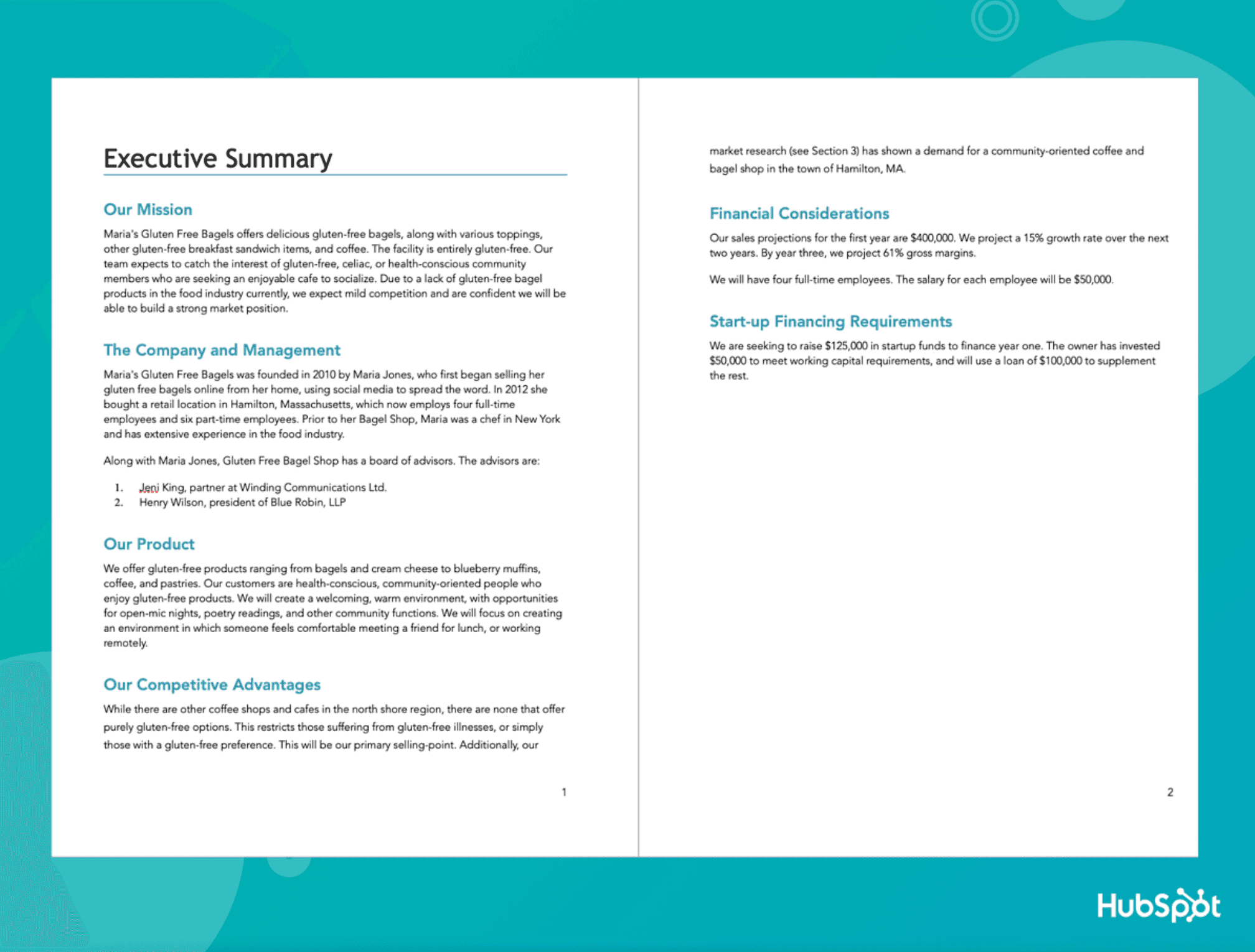
2. Develop A Mission Statement
The first step in creating a marketing plan is to develop a mission statement. You need a basic understanding of what your company is trying to achieve and where it’s headed, like this example from CoSchedule.
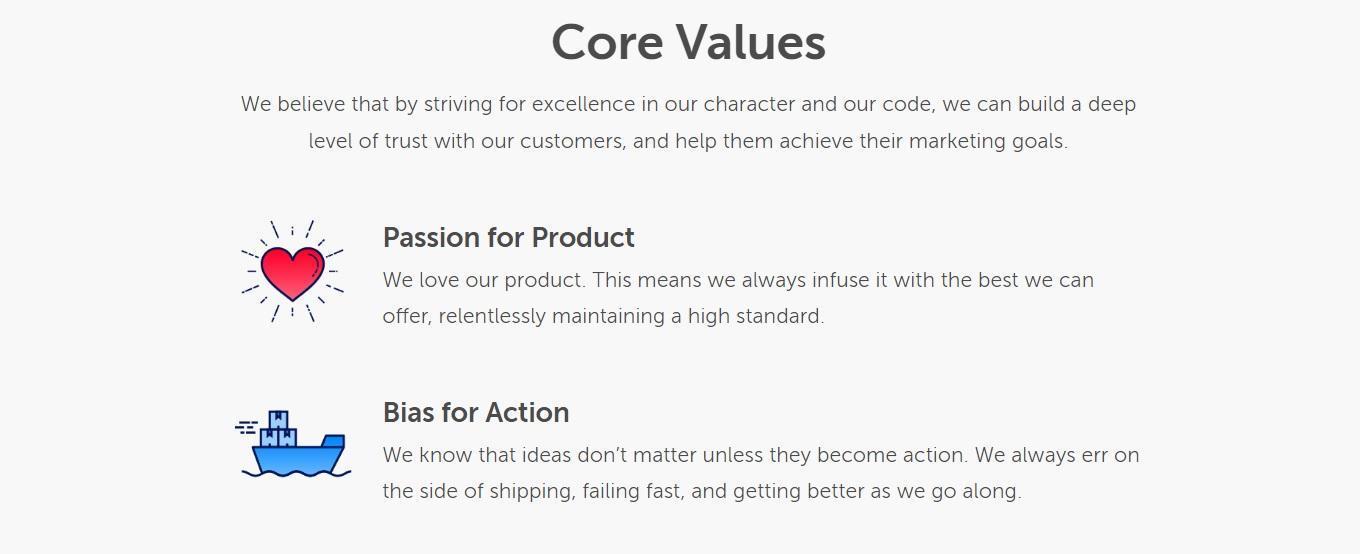
The statement should also briefly describe the purpose of your marketing efforts. It should be clear, short, and easy to understand. Once you have developed your mission statement, you can use it to guide the rest of your marketing planning.
3. Set Your Marketing Goals
What will success look like in your marketing plan? This section will establish your financial and non-financial goals. Vital Marketing recommends setting two main goals and three to five supporting goals. Marketers who set goals are 376% more likely to report success.
Establish your financial goals:
- How much money do you want to generate with your marketing?
- Can you break that revenue down into a specific number of sales?
- How can you make your marketing earnings and spending align with your business goals?
Hash out your non-financial goals:
- Put out fresh content without increasing your workload
- Get better mileage out of your best content
- Re-use content that didn’t perform well but had great promise
Once you know your goals, it’s also crucial for you to define your marketing objectives. When you define those, you can understand if you’ve successfully reached your goals in a clear and quantifiable way.
4. Set Your KPIs
Key Performance Indicators (or KPIs) track progress and measure success in marketing. Common marketing KPIs include website traffic, conversion rate, cost-per-acquisition, number of leads, and more. You might already be sourcing some social media KPIs from your CoSchedule’s analytics dashboards, such as Engagement Rate or Total Engagements.
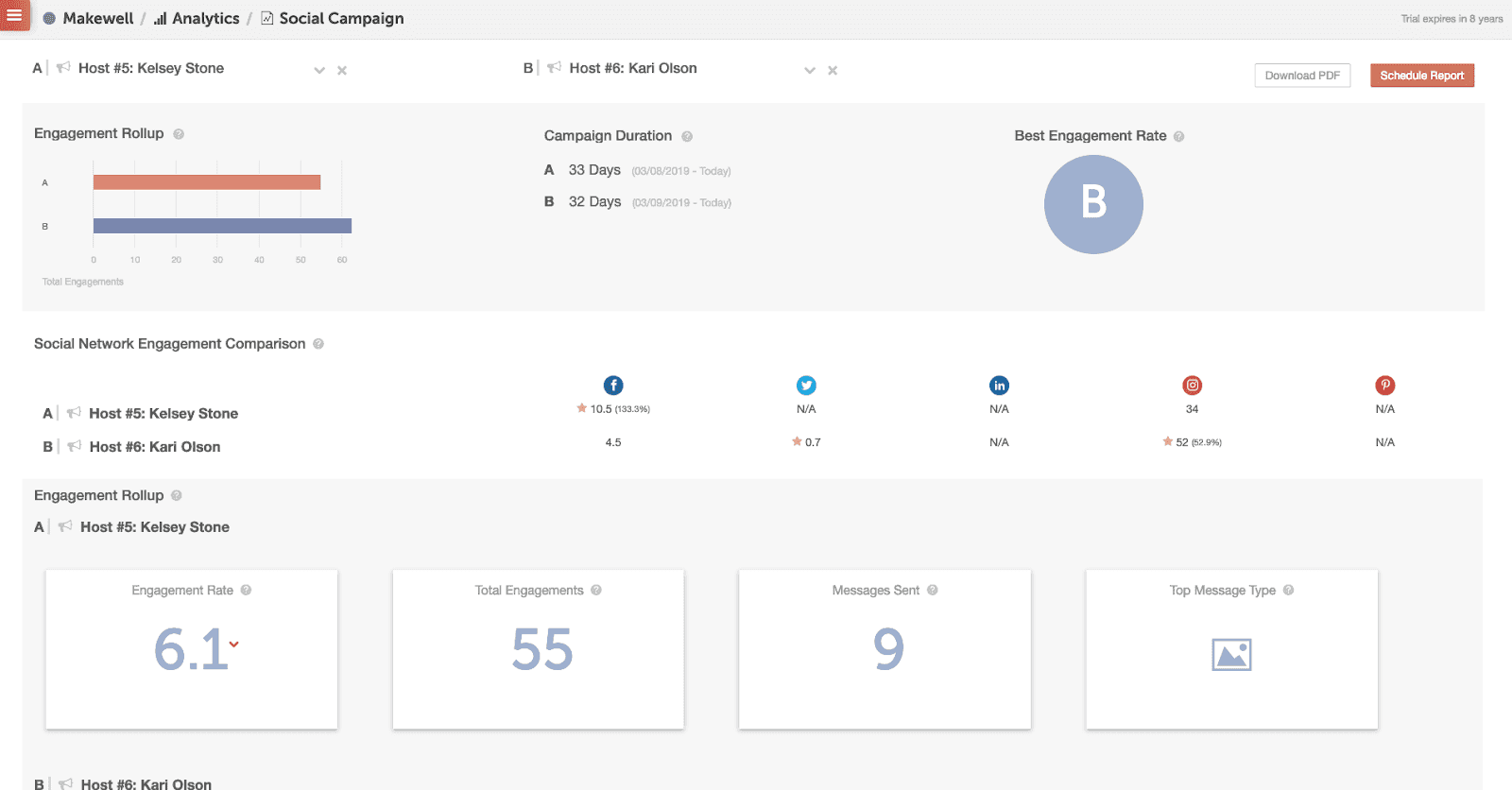
When selecting which KPIs to feature in your marketing plan, consider the following elements:
-
-
- What lead indicators could you monitor that have high potential to meet your goals?
- What actions must prospective customers take for them to achieve your goals?
- How will you monitor if these lead indicators and activities are happening as desired?
-
5. Define Your Buyer Personas
Buyer personas are semi-fictional representations of your ideal customer. They are based on market research and real data about your existing customers.
Don’t underestimate the power of buyer personas. Well-thought-out personas can help you better understand your target audience and create better initiatives. Marketing campaigns are the most successful when they resonate with the people you’re trying to reach.
Where do you start?
We recommend starting your target audience research for your marketing plan with these questions:
- How would we describe our current best customers?
- Why did these customers look for a product or service like ours?
- Why did they hire us?
- How do these customers benefit from choosing us over the competition?
As an example, BusinessTown’s marketing plan takes a unique approach in their target audience description for a hypothetical landscaping company by also noting what customers they don’t want to target:
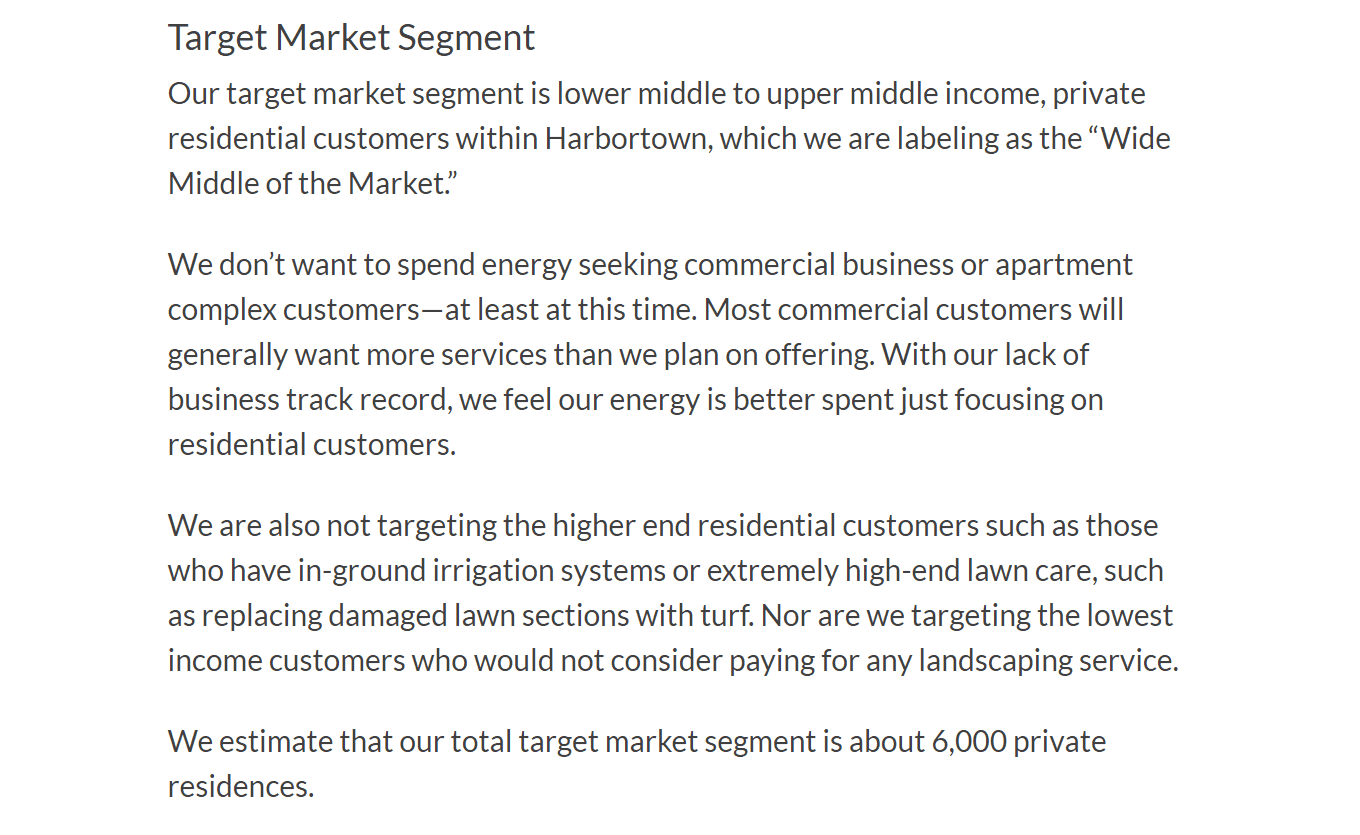
Check out Indie Game Girl’s example of a marketing plan buyer persona:

6. Perform Competitive Research & Situational Analysis
Your situational analysis will help you understand your marketing situation at a glance. By researching your competitors, you can understand their strengths and weaknesses and, by comparison, learn more about your own. Include these elements in it:
Company Outline:
- Statistics about company size, locations, employees, etc.
- Tagline
- Unique selling proposition
- Sector
- Brand awareness
Competitor Outline (one per major competitor):
- Products
- Universal selling point
- Strengths compared to your organization
- Weaknesses compared to your organization
Environmental Factors:
- Internal
- External
- Economic
- Sociological
- Industry trends
7. Implement Goal-Oriented Initiatives
Within a marketing plan, there could be several initiatives. Initiatives are key focus areas that leverage your company’s strengths and opportunities and successfully influence the most profitable customer action.
All initiatives must conclude in reaching one or more of the strategic business objectives and marketing goals.
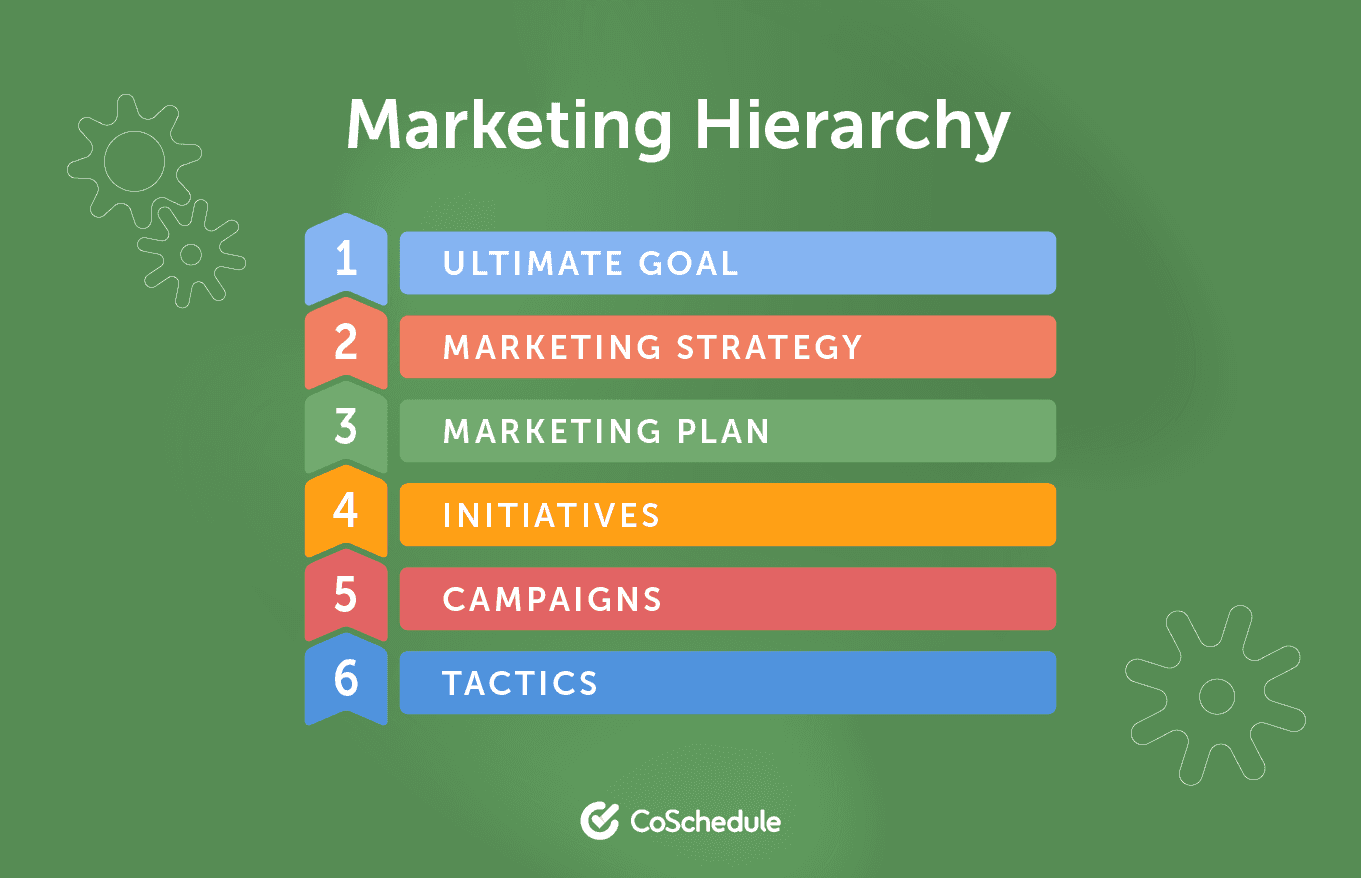 For example, if your goal is to increase brand awareness, your initiatives might include starting a social media campaign and doing manual sales outreach.
For example, if your goal is to increase brand awareness, your initiatives might include starting a social media campaign and doing manual sales outreach.
Ideally, initiatives should align and “talk to each other” to create a consistent customer experience.
Answer the following questions to get an idea of your initiatives:
- What are your target industries?
- What are your target verticals?
- What marketing tactics will you use to reach your target market?
- What marketing channels will you use to get your target market?
- What types of content will you publish and promote to reach your target market?
- What should your marketing funnel look like to influence your marketing goals?
8. Embrace Your Responsibilities
For a marketing plan to be successful, you need buy-in and support from all marketing team members. However, it’s also important to ensure that each team member understands where, how, and when they need to contribute.
Ideally, you should have a project lead who oversees each campaign as it flows through the cross-functional team.
Couple that with an established internal process, and the workflow will be smooth, and you will meet your goals.
For example, if the marketing team wanted to release a new ebook, the content, social, and product marketing teams would all have to work together in a cross-functional manner to make it happen.
The Content Strategist or the Content Marketing Manager would likely be the one spearheading the project.
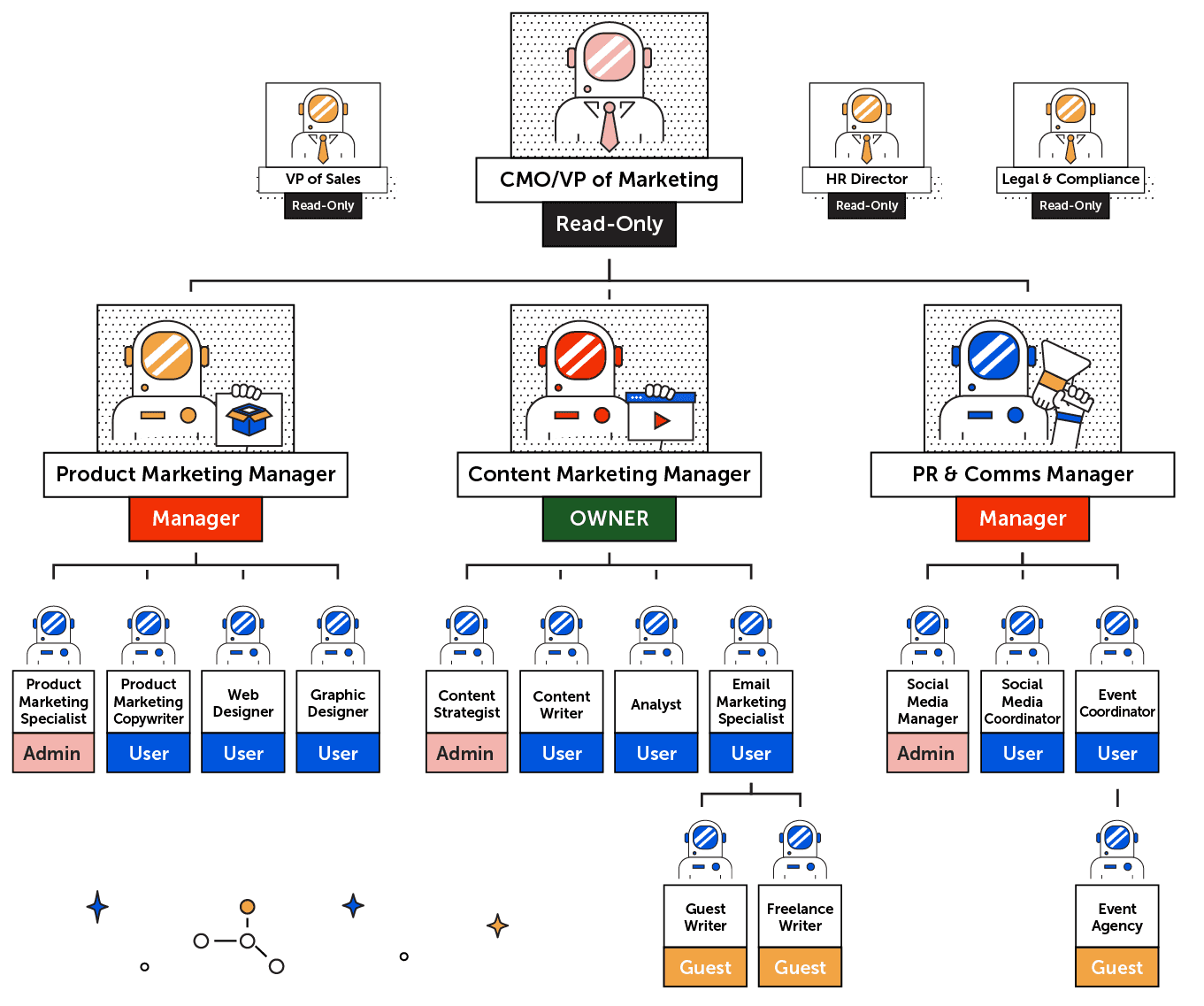
Get started by asking yourself a few questions:
- What departments must be involved to execute the initiatives effectively?
- What teams within departments must be involved?
- What specific roles must be involved?
- What particular people must be involved?
- What will each person’s responsibilities be?
- How will you hold each person accountable for completing their duties?
- Who needs to be involved in approvals?
- What cross-functional frameworks must exist to operate effectively and efficiently?
9. Determine Your Marketing Budget
Include an overview of your budget and spending priorities in your marketing plan. This budget summary will help you make marketing decisions faster by giving them a financial context.
First, make sure you have a defined total budget. We discuss ways to calculate your marketing budget in the Marketing Strategy Hub.
Marketing Budget
Your marketing budget is the planned amount of money you’ll spend to make your marketing goal a reality.
Once you have that total number, break it down into the costs for each project you want to do. Organize your tasks into needs and wants:
- Needs: Projects your business needs to execute for a successful marketing strategy.
- Wants: Projects that are nice to have but don’t necessarily tie into your greater marketing strategy.
Write down how much your needs will cost. Then, you can delegate what you have left in your total budget to your most important wants.
10. Use An Editorial Calendar To Plan Your Content
An editorial calendar is a tool you can use to plan and schedule content. It can track deadlines, ensure that all content pieces align with the marketing objectives, and keep the marketing team organized.
Editorial calendars can come in many different formats.
Monthly
A monthly editorial calendar usually lists the most details about upcoming campaigns. You can use this type of calendar to track deadlines, content topics, and who is responsible for each task.
Quarterly
A quarterly editorial calendar offers a more broad view of upcoming content. This type of calendar can plan out themes or marketing initiatives that will span multiple months.
Annually
Establish an annual editorial calendar if you want to see your marketing plan through a bird’s eye view. It covers the most high-level initiatives and can be used to track the overall brand narrative and align business objectives.
12 Steps In The Marketing Planning Process
Marketing planning is a crucial aspect of any successful marketing campaign. It involves a systematic approach to identifying and analyzing potential opportunities, developing a comprehensive plan, executing the plan, and measuring results to make improvements in the future. A well-planned marketing strategy can help companies achieve their marketing goals, enhance their brand image, and increase revenue.
The marketing planning process includes twelve steps, which are divided into three broad phases: strategizing, planning, and execution. In this section, we will discuss these steps in detail.

Step 1: Strategize
The first step in the marketing planning process is to develop a strategic plan. This involves identifying opportunities and options, brainstorming and prioritizing ideas, and determining the best action to achieve your marketing objectives.
Opportunities brainstorming and prioritization: This step involves brainstorming ideas and prioritizing them based on their potential impact on your marketing goals. It is essential to consider various opportunities, including market trends, consumer behavior, industry developments, and competitor actions.
Options brainstorming and prioritization: After identifying potential opportunities, the next step is brainstorming various options for capitalizing on them. This could include developing new products or services, refining existing ones, or improving your marketing tactics.
Step 2: Plan
The planning phase involves developing a comprehensive plan for your marketing campaign. This includes creating a creative/project brief, defining expectations against which you may hold contributors accountable, establishing campaign and project timelines, and gaining stakeholder awareness, opinions, and approval.
One of the most important aspects of this step is to create a brief. A creative brief outlines your marketing campaign’s objectives, target audience, messaging, and design elements. This document serves as a guide for all team members involved in the campaign.
You will also need to set the expectations against which you may hold contributors accountable. Setting clear expectations for team members is essential to ensure everyone is on the same page regarding goals and timelines.
Finally, there will need to be some form of stakeholder awareness, opinion gathering, and approval. Maintaining stakeholder awareness, opinions, and approval helps ensure the campaign aligns with the company’s overall strategy and goals.
Step 3: Write
The third step in the marketing planning process is to develop written content for the campaign. This is a critical step, as the written content serves as the backbone of any marketing campaign. Without compelling messaging and copy, the design and visuals of the campaign are unlikely to have the desired impact on the target audience.
In some cases, it may be necessary to engage a professional copywriter or content creator to develop the written content. This can be particularly beneficial for larger or more complex campaigns where the messaging needs to be finely tuned to achieve the desired impact.
Step 4: Design/Record
The next step is to create the design elements of the campaign, such as graphics, videos, and other visual content. This step involves collaborating with designers, videographers, and other creative professionals to bring the campaign to life.
Ensuring that every aspect aligns with the brand vision and aesthetic will help create a sense of continuity. This helps the reader feel that it is tied into the other marketing elements already in place and provides a professional component to each piece.
Step 5: Edit
The editing phase involves revising all campaign elements, including text and visual content, such as graphics, videos, animations, and so on. It is essential in creating an impactful campaign, as your campaign elements will catch the target audience’s attention and convey the intended message.
These elements are generally created in collaboration with a team of professionals, including graphic designers, videographers, animators, writers, and other creative professionals. These individuals have the technical expertise and creative skills required to produce high-quality content. The editing process ensures that all text and visual elements align with the brand’s messaging and tone of voice.
Step 6: Stage
The staging phase involves preparing the campaign for launch. This could include setting up social media accounts, scheduling email campaigns, and designing other promotional materials. This phase typically involves several key activities, including:
If social media is part of the campaign strategy, setting up social media accounts before launch is essential. This includes creating accounts on all relevant social media platforms and ensuring their optimization for the campaign’s messaging and branding.
Email marketing is an effective way to reach a target audience directly. Marketers should schedule email campaigns in advance and test them thoroughly before launch to ensure that the campaign’s email marketing efforts are effective.
The campaign’s website is a critical component of the overall strategy. Before launch, marketers should ensure that the website is fully functional, optimized for SEO, and aligned with the campaign’s messaging and branding.
Step 7: Quality Assurance
Quality assurance is a critical step in the marketing planning process. This involves testing the campaign to ensure that all elements function correctly and that the messaging is clear and effective. The QA process typically involves several key activities, including:
Functionality testing: Functionality testing involves checking that all campaign elements, such as the website, landing pages, and email campaigns, function correctly. This includes testing links, forms, and other interactive elements to ensure they work as expected.
Usability testing: Usability testing involves testing the user experience to ensure it is easy to navigate and use. This could include testing the website’s layout, the clarity of the messaging, and the ease of use of interactive elements.
Performance testing: Performance testing involves testing the speed and responsiveness of the campaign. This could include testing the website’s load time, the speed of email campaigns, and the responsiveness of interactive elements.
Cross-platform testing: Cross-platform testing involves testing the campaign across different devices and platforms. This ensures that the campaign works correctly on desktop computers, mobile devices, and different web browsers.
Content testing: Content testing involves testing the campaign’s messaging to ensure it is clear, effective, and aligned with its objectives. This could include testing headlines, body copy, and calls to action to ensure they resonate with the target audience.
Step 8: Publish
The publish phase involves launching the campaign and making it available to the target audience. This phase is critical to the success of the campaign. It marks the culmination of all the planning and execution efforts of the marketing team and is the point at which the campaign is launched and made available to the target audience.
Step 9: Measure
The measurement phase occurs after the campaign has been launched and is critical to evaluating the success of the campaign. The measurement phase involves tracking and analyzing data related to the campaign’s performance against the established objectives.
During the measurement phase, several key activities take place, including:
Tracking metrics: It is essential to track metrics that align with the campaign’s objectives. These could include website traffic, social media engagement, email open and click-through rates, conversion rates, or other relevant metrics.
Analyzing data: The data collected during the measurement phase is analyzed to evaluate the campaign’s performance against the established objectives. This analysis can help identify areas of success and areas that may require improvement.
Making adjustments: Based on the data and analysis, adjustments may be made to the campaign strategy. This could involve adjusting the messaging, refining the targeting, or adjusting the budget.
Continuously monitoring: It is important to monitor the campaign’s performance throughout the measurement phase to ensure it meets the established objectives.
Step 10: Retrospective Analysis
After the campaign is complete, the team should conduct a retrospective analysis to identify what went well, what didn’t, and what could be done differently in the future.
This information should come from collecting feedback from all stakeholders involved in the campaign, including team members, clients, and vendors. Feedback can be gathered through surveys, interviews, or other means.
The team should develop action plans to improve future campaigns based on feedback, evaluation, and analysis. These action plans could include adjusting the campaign strategy, refining the targeting, or improving the planning and execution processes.
Step 11: Review & Report
The review and reporting phase involves sharing the campaign results with stakeholders, including executives, shareholders, and employees.
Based on the information gathered and the initial steps taken in the previous step, this step helps define the actionable steps that will be taken on future initiatives and will vastly improve the efforts moving forward. It will also provide a written document that can be used to benchmark all campaigns.
Step 12: Iterate
The final step in the marketing planning process is to use the knowledge gained from the retrospective analysis and stakeholder feedback to iterate on future campaigns. This could involve refining the marketing strategy, adjusting messaging, or changing tactics to reach the target audience.
At CoSchedule, we use our knowledge-sharing platform, Guru, to share all changed processes or integration steps after every campaign. This enables all team members to stay up-to-date on the new policies in one centralized location that can be accessed anytime.
It is important to note that the marketing planning process is not linear, and each step is interconnected. As such, marketers should be flexible and adapt their approach as needed based on feedback and results.
The marketing planning process is a comprehensive approach to developing and executing successful marketing campaigns. Following the steps outlined in this section, marketers can develop effective campaigns that achieve their objectives, enhance their brand image, and increase revenue. The key to success is to remain agile and adaptable, using feedback and data to inform future campaigns and improve results over time.
Marketing Plan FAQs
What Is The Difference Between A Marketing Plan Vs. A Business Plan?
A business plan documents the highest-level strategy for an organization, including essentials such as mission, vision, values, assets, human resources, and more.
A marketing plan documents how your team will execute a marketing strategy. The marketing strategy is based on the “north star” vision, which is documented in the business plan. It translates the “north star” vision into tangible actions marketers can perform to achieve their goals using their skill sets and contributions.
What Is A Marketing Plan Template?
A marketing plan template is a tool that organizations use to outline and track their marketing initiatives. A marketing plan template can be as straightforward or complex as you need it to be.
The important thing is that it includes all the critical information you will need to track your progress and measure your success.
What Is An Executive Summary In A Marketing Plan?
An executive summary is a brief overview of the marketing plan. It should include the marketing objectives, key initiatives, and expected results. The executive summary should be concise and to the point.
What Is A Top-Down Marketing Strategy?
A top-down marketing strategy is an approach where senior executives drive the marketing plan, initiatives, and goals. These details trickle down in the hierarchy, and managers, specialists, and associates will try to match the plans with campaigns and tactics.
What Is A Bottom-Up Marketing Strategy?
A bottom-up marketing strategy flips the traditional model on its head. In this scenario, employees of all levels are involved in developing marketing initiatives. This marketing strategy often results in more buy-in and support from employees.
What Are The 5 Elements Of A Marketing Plan?
The 5 elements of a marketing plan typically refer to the 5 Ps of marketing, also known as the marketing mix: product, price, place, promotion, and packaging.
What Are The 7 Elements Of A Marketing Plan?
The 7 elements of a marketing plan traditionally include the 7 Ps of marketing, also called the marketing mix: product, price, place, promotion, packaging, positioning, and people.
What Is An Example Of A Marketing Plan?
Here is a one-page marketing plan example from CoSchedule:
Read this resource for a full list of marketing plan samples and examples from 40+ organizations.
How Do I Build A Marketing Plan?
The best way to build a marketing plan will vary depending on your organization’s needs. In any case, you’ll need to define your goals, conduct market research, follow a marketing strategy, create efficient campaigns, and keep track of your achievements. Then you’ve got yourself a marketing plan!
